Showing top 0 results 0 results found
Showing top 0 results 0 results found

Are you leveraging chatbots' power in your marketing strategy? As digital interactions continue to evolve, chatbots are becoming an essential tool for businesses.
In fact, 39% of all chats between businesses and consumers now involve a chatbot, highlighting their increasing role in customer communication.
This guide will explore how you can effectively utilize chatbots to enhance your marketing efforts, streamline customer service, and boost engagement.
In this article, we'll cover key topics such as:
- What chatbots are and how they work.
- The benefits of using chatbots in marketing.
- Effective strategies for deploying chatbots.
- Common pitfalls to avoid in chatbot marketing.
- Step-by-step guide on setting up a marketing chatbot with ChatBot.
Join us as we dive into the world of chatbots and discover how they can transform your marketing strategy in 2024.
What are chatbots?
They are commonly used on platforms like SMS, website chat interfaces, and social messaging services such as Messenger and WhatsApp.
Read more: Chatbot vs. Conversational AI: What is the Difference?
What is chatbot marketing?
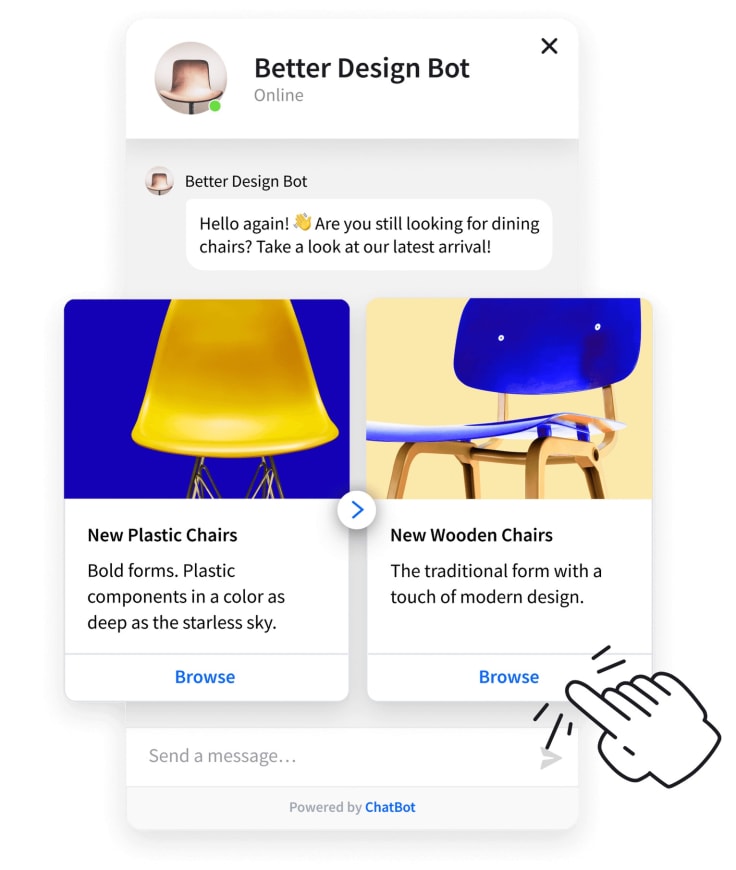
Chatbot marketing utilizes automated programs to seamlessly interact with both potential and existing customers through your website or app, allowing for engagement at any time without needing live personnel. This strategy helps efficiently generate leads and close sales and enhances customer interaction by initiating conversations, qualifying leads, and upselling products based on specific rules.
For example, you could deploy a chatbot to personally greet visitors who linger on your pricing page, enhancing the feeling of a tailored experience and promptly addressing their interests, which is crucial for converting curiosity into tangible actions.
With 84% of companies believing that AI chatbots will increasingly become a crucial part of customer-business communications, conversational marketing chatbots are primed to offer precise and timely interactions.
What are the benefits of using chatbots for marketing?
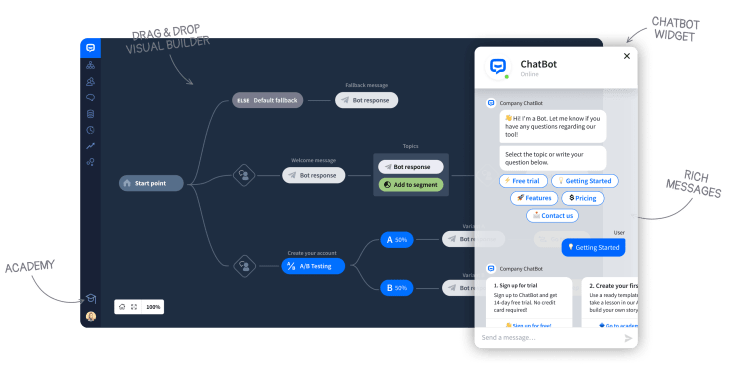
Chatbots have transformed the digital marketing landscape by automating interactions with customer queries, enhancing the customer journey, and streamlining the process of generating qualified leads and closing sales. Here are some key benefits of integrating chatbots into your marketing strategy:
Engage and qualify leads
Marketing chatbots significantly boost engagement by welcoming website visitors with friendly prompts or interactive welcome videos, creating a more dynamic and responsive site experience. For instance, a chatbot might initiate a dialogue by asking visitors simple questions to collect basic information such as email addresses and company sizes.
This data is then used to personalize the conversation and steer the visitor toward specific actions, like signing up for a newsletter or scheduling a demo. This proactive approach to engagement effectively nurtures qualified leads and ensures continuous lead generation, supporting marketing teams even when they are offline.
With 36% of businesses implementing chatbots to enhance their lead generation strategies, integrating this technology can greatly improve how you interact with and convert potential customers.
Direct high-intent leads to sales
Chatbots excel in identifying and acting on signals of high buyer intent. If a visitor spends time on your pricing page or interacts with specific content, the chatbot can instantly engage them, qualify their interest, and if suitable, schedule a call with your sales team. This direct approach minimizes the delay in response, increasing the likelihood of swiftly closing a sale.
Boost engagement and sales
Using chatbots for conversational marketing can elevate customer engagement levels and drive sales. For instance, AI-powered chatbots programmed to assist with orders can guide customers through the buying process, offer personalized promotions, and capture sales even outside of standard business hours.
This capability is backed by research from Juniper, which forecasts a significant increase in chatbot-driven transactions in the coming years.
Segment traffic effectively
Chatbots are also adept at segmenting traffic, which allows for more targeted and effective marketing strategies. By identifying user interests based on their interactions, chatbots can classify leads accurately and engage them with the right messages at the right time, enhancing the overall marketing ROI.
Provide 24/7 availability
One of the most significant advantages of chatbots is their ability to provide round-the-clock service. Whether a customer visits your website at noon or midnight, the chatbot is there to offer assistance, making your brand more accessible and responsive to customer needs.
Collect and leverage data for insights
Chatbots can collect valuable data such as visitor names, contact details, and preferences during interactions. This information can be used to refine marketing strategies and improve chatbot interactions over time, ensuring that your marketing efforts are more effective and personalized.
Lead qualification
Speed is crucial in lead qualification. Marketing chatbots can respond to queries instantly, regardless of the time or day, which significantly increases the chances of qualifying leads and converting them into customers.
How to use chatbots in marketing
Here’s how you can effectively employ chatbots in various marketing activities, using examples from successful implementations, including those facilitated by platforms like ChatBot.
Taking orders
In the realm of ecommerce, chatbots are revolutionizing the way businesses handle transactions. For instance, a chatbot can proactively engage customers who have shown interest in a product by sending timely notifications or personalized recommendations.
This enhances the shopping experience and increases the likelihood of completing a sale.
At ChatBot, we enable businesses to customize these interactions, ensuring each recommendation feels personal and relevant to the user's specific interests.
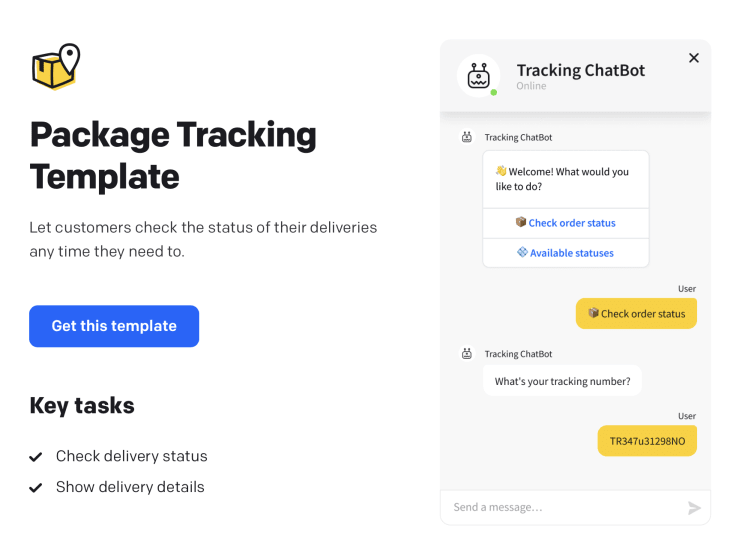
Scheduling appointments
Chatbots streamline the appointment scheduling process across various industries. For services such as beauty salons or fitness centers, integrating your scheduling system with a chatbot can offer customers a hassle-free way to book appointments.
The chatbot can inquire about preferred dates and times and even handle rescheduling requests without human intervention. This convenience improves customer satisfaction and optimizes your booking system’s efficiency.
Promoting products and services
Chatbots are also invaluable for ongoing marketing campaigns promoting products or services. Businesses can automate parts of the sales funnel, such as product recommendations based on user behavior or previous purchases by using chatbots.
For example, if a customer regularly buys skin care products from your beauty store, the chatbot can alert them to new arrivals or exclusive deals. ChatBot’s platform allows for this level of customization, enabling businesses to send targeted messages that are aligned with the user's interests and previous interactions.
Distributing news and updates
Keeping customers informed about new products, services, or company updates is crucial for maintaining engagement. Chatbot platforms can deliver marketing messages directly to users, ensuring they stay informed and engaged with your brand.
Whether it’s a product launch, a seasonal promotion, or a company event, chatbots can ensure your news effectively reaches your audience. This strategy makes your brand memorable and drives traffic back to your site.
Chatbot marketing examples
Chatbots are more than just tools for automating customer service; they're revolutionizing how brands interact with their customers, making each interaction more personalized and timely.
Here are the best chatbot use cases of brands using bots to uplift their marketing efforts.
Mindvalley’s personalized learning recommendations
Mindvalley, a platform dedicated to personal growth, utilizes a chatbot on its Facebook Messenger to guide potential learners through its vast offerings. After users select their interests, the chatbot suggests courses tailored to their needs.
It’s designed to mimic a conversation with a supportive advisor, providing options and offering a direct line to human support if users prefer. This dual approach caters to different comfort levels with technology and personalizes the learning journey, making it more likely for users to enroll.
LEGO's interactive gift guide
During the holiday season, LEGO introduced a chatbot aimed at helping parents pick the perfect gift. This chatbot would start by asking a few simple questions about the child's age and interests, making the selection process less overwhelming. Once it had enough information, it presented a curated list of LEGO sets that matched the criteria.
Furthermore, it included links to local stores or online purchase options, turning a simple inquiry into a streamlined shopping experience. This thoughtful integration helped LEGO boost their sales and customer satisfaction during a crucial shopping period.
Roma by Rochi's fashion-forward bot
Roma by Rochi, an ecommerce clothing store, uses a chatbot to enhance the online shopping experience. The bot is set up to field customer inquiries, display the latest product catalog, and alert customers to sales and promotions.
What makes this bot effective is its ability to provide real-time updates and offers based on user behavior and preferences, mimicking an in-store salesperson’s assistance, which can lead to increased sales and customer loyalty.
Lidl's wine selector
Lidl UK introduced a chatbot that helps wine enthusiasts select the perfect bottle. Customers can receive recommendations based on food pairings, taste preferences, or specific wine searches by interacting with the chatbot.
This adds a layer of interactive fun to wine shopping and educates the customers, helping them make informed purchases they're likely to enjoy. The chatbot thus acts as both a sommelier and a sales assistant, enhancing the customer experience and increasing sales.
Run effective marketing campaigns with ChatBot 🚀
H&M’s interactive product finder
H&M's chatbot simplifies finding the right product by allowing customers to enter keywords or upload photos. The chatbot then processes this information to direct customers to the correct product page, effectively reducing searching time and improving the overall user experience. This tool is particularly helpful during sales or promotional periods when customers are looking to find deals quickly.
Kaysun Corporation's B2B engagement
In the B2B sector, Kaysun Corporation uses a chatbot to respond immediately to client inquiries. This is crucial in industries where timing can influence purchasing decisions. The chatbot is programmed to handle a range of queries, from simple product information to more complex service details, ensuring that potential clients have all the information they need to proceed without any delays.
Hola Sun Holidays’ travel assistance
Hola Sun Holidays uses a travel chatbot to ensure every customer query is answered promptly, even outside business hours. This is particularly important in the travel industry, where timely responses can be the difference between a booking and a missed opportunity. The chatbot provides information on vacation packages, booking details, and more, acting as a 24/7 travel assistant.
Whole Foods Market’s recipe explorer
Whole Foods Market employs a chatbot to help customers explore its vast collection of recipes. Users can search for recipes based on specific ingredients, meal types, or dietary restrictions. The chatbot enhances the shopping experience by suggesting recipes and then guiding customers to the ingredients needed, which are available in their stores. This drives sales and positions Whole Foods as a helpful and health-conscious brand.
1-800-Flowers’ direct ordering
1-800-Flowers was an early adopter of chatbot technology, using it to simplify the flower ordering process. Customers can quickly select flowers, arrange delivery times, and resolve queries through the chatbot. This convenience is a significant advantage, especially during high-volume periods like Valentine’s Day and Mother’s Day, ensuring that customers receive timely and stress-free service.
Read more: What is the Future of Chatbots? Top Chatbot Trends to Follow in 2024
Tips for an effective chatbot marketing strategy

Implementing a chatbot can significantly enhance how you interact with visitors and convert them into customers. To ensure your chatbot marketing strategy is successful, consider these chatbot best practices:
- Set clear objectives: Begin by defining what you hope to achieve with your chatbot—whether it's increasing sales, boosting subscription numbers, or enhancing the shopping experience. Setting specific goals will help you measure the effectiveness of your chatbot strategy.
- Choose the right chatbot provider: Opt for a reliable chatbot platform rather than building one in-house. This approach is typically more cost-effective and less time-consuming. A good provider will offer AI-driven chatbots tailored to marketing needs, streamlining the setup process.
- Offer live chat options: While chatbots are efficient, some users prefer interacting with a human. Ensure users can easily switch to live chat when they need more personalized assistance, which can help preserve leads and facilitate sales.
- Select appropriate chatbots for marketing: Utilize chatbots specifically designed for marketing, such as those for product recommendations, placing orders, or scheduling appointments. Each type of chatbot has features suited to different marketing tasks.
- Personalize your bot’s voice: Match the chatbot’s tone and style to your brand. If your brand is more serious, keep the bot professional; if it’s playful, a light-hearted bot can make interactions more enjoyable.
- Incorporate quiz chatbots: Deploy quiz-style chatbots to engage users and gather useful data by asking about their preferences and needs. This information can be used to refine your marketing strategies and provide more personalized recommendations.
- Utilize chatbot newsletters: In addition to traditional email newsletters, use chatbots to send brief updates about new releases, sales, or special offers directly to users on your website. This keeps your audience engaged and informed.
- Integrate with social media ads: Connect your Facebook ads to a Messenger chatbot to enhance engagement. Interactive quizzes and product showcases via chatbots can lead to higher click-through rates and better engagement.
- Collect feedback regularly: After interactions, deploy chatbots to collect customer feedback through satisfaction surveys, enhancing your understanding of the customer journey. Customer feedback is invaluable for understanding customer preferences and improving your services.
- Monitor and adjust performance: Regularly monitor your chatbot's performance using analytics tools to better understand how they handle customer queries and contribute to lead qualification. The chatbot’s decision-making processes can be adjusted based on these insights to enhance effectiveness over time.
By following these tips, you can create a chatbot strategy that meets your business's needs and significantly improves your interaction with customers, strengthening and enhancing your digital presence.
What should be avoided in chatbot marketing?
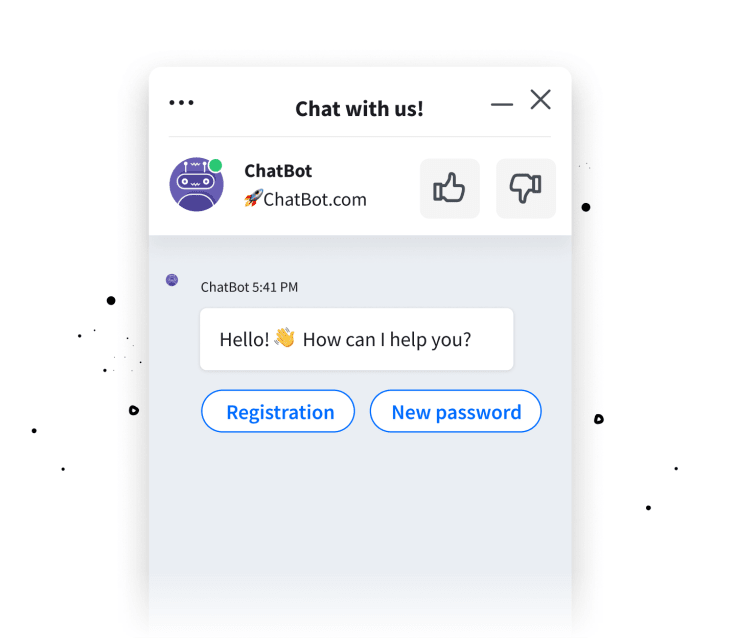
While chatbots are a powerful tool for enhancing customer engagement and streamlining marketing efforts, certain practices can diminish their effectiveness and potentially harm your brand.
Here are some key pitfalls to avoid in chatbot marketing:
- Avoid over-reliance on chatbots: Don’t let chatbots be your only point of contact. Integrate them with other marketing channels like SEO, email marketing, and especially live chat. This integration ensures a well-rounded communication strategy that preserves the human element in customer interactions.
- Regularly update and monitor your chatbots: Setting up a chatbot is just the beginning. Continuous monitoring, updating, and optimizing are crucial to keep the chatbot relevant and effective. Regular reviews and updates will help maintain its performance and relevance to your audience.
- Be mindful of message frequency: It’s important to strike the right balance in communication. Bombarding visitors with too many automated messages can be off-putting and may lead to them disengaging with your brand. Use discretion in how often your chatbot reaches out to customers to maintain a positive interaction experience.
By avoiding these common mistakes, you can ensure that your chatbot becomes a valuable asset to your marketing strategy rather than a nuisance. This thoughtful approach will help preserve your brand’s reputation and enhance customer satisfaction.
How to set up marketing chatbots with ChatBot
Setting up a marketing chatbot with ChatBot is straightforward, even if you have no coding experience.
Here’s a simple step-by-step guide to get you started:
1. Start your free trial: Sign up for a free trial on ChatBot and activate your account.
2. Create your chatbot: Navigate to the ChatBot dashboard and click the Add chatbot button.
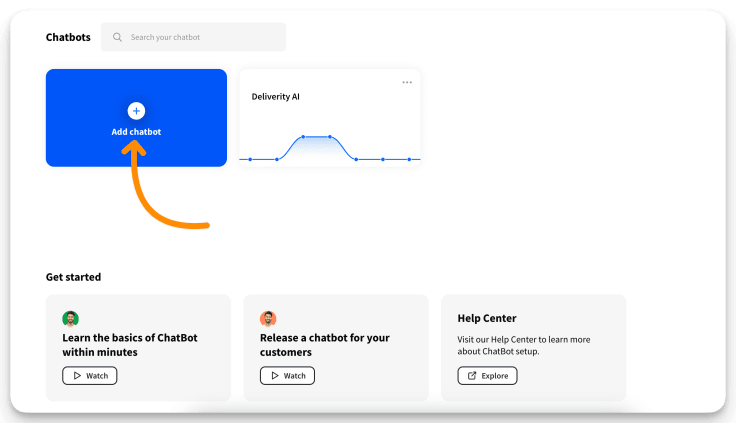
3. Choose your setup method: You can either use a pre-designed template, build from scratch, or scan your website to automatically create a bot tailored to your content.
4. Customize your chatbot: Using the Visual Builder, start with a basic conversation tree. Edit the default welcome message to make it catchy and reflect your brand.

5. Add responses and interactions: Drag and drop different response types like text, images, and quick replies. Customize these to match the flow of conversation you envision.
6. Set up user inputs: Define keywords or phrases that trigger specific bot responses, ensuring the chatbot can effectively interact with users based on their inputs.

7. Collect essential data: Use the Question block to gather important information, such as email addresses, ensuring responses meet your data validation criteria.
8. Test and refine: Test your chatbot within the ChatBot platform to catch and correct any issues before going live.

9. Deploy your chatbot: Once you’re satisfied, use the Publish and Integrations options to place your chatbot on your website or preferred platform.
10. Monitor and improve: Keep an eye on interactions and continually refine your chatbot based on user feedback and performance metrics.
ChatBot also offers a variety of templates that can significantly simplify the setup process and provide inspiration for different use cases, helping you create an effective marketing chatbot tailored to your specific needs.
Conclusion
As we've explored, chatbots offer a dynamic and efficient way to enhance your marketing strategy. They provide round-the-clock engagement and personalized customer experiences. They're not just tools. They're collaborative partners that help bridge the gap between potential leads and loyal customers.
With the right setup and strategy, as outlined with the help of ChatBot, you can transform your marketing efforts and see tangible results in customer satisfaction and sales.
Embracing chatbots is about enhancing the connections you create with your audience—making every interaction count, whether it’s answering a simple query or guiding a customer through a complex buying process. Remember, the goal is to integrate chatbots seamlessly into your marketing mix, ensuring they complement rather than dominate your brand's human touch.
So, keep these tips and examples in mind whether you're just starting out or looking to refine your existing chatbot strategies. Stay true to your brand's voice, be responsive to customer needs, and continually adapt to feedback. That’s how you turn the potential of chatbot for marketing into real-world success.
Run effective marketing campaigns with ChatBot 🚀



